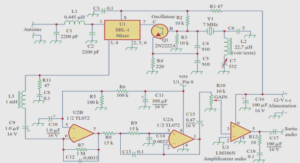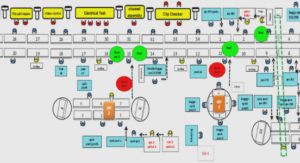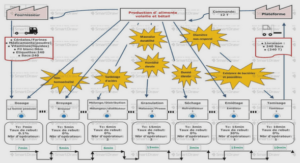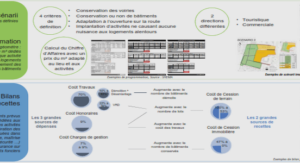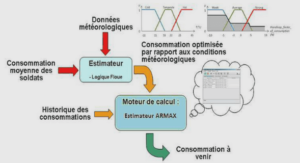Planets in a terrestrial orbit
Time series
In this section, we present the analysis of the orbital light curves and the physical parameters that have an influence on the signal. Figure 5.15 represents the orbital thermal light curve of the planet for observers at conjunction and observers at opposition for several inclinations of the planetary view, labeled by the latitude of the sub-observer’s point. To study the effect of clouds on the signal, we have calculated the Cloud Radiative Forcing (CRF) (Section 2.2) at any time of observation. Figure 5.16 gives the CRF correspondent to the time series. As the clouds absorb the emission from below, CRF (=Fall−sky – Fclear) is a negative magnitude. Table 5.4 presents the time series variability. It is also useful to associate the time series with the rotation maps from Figure 5.5 to Figure 5.10. 108 5. Planets in a terrestrial orbit
The Earth (Ete–1)
Comparing the light curves obtained at conjunction and at opposition of Figure 5.15, we do not observe a substantial difference in flux with a change in the planetary phase angle. The signal shows a combination of several effects: the large modulation reprints the seasonal cycle with a predominance of the NH because of the uneven distribution of continents, and the smaller variability is due to the passage of warm regions (Sahara) and cold regions (Indonesia) (Chapter 4) with the rotation of the planet. The cloud production is higher during summer, specially in the NH, due to the temperature increase.
The slow Earth
As in the case of the Earth, the light curve of Ete–10 has also a seasonal and a rotational variation. However, the slow Earth is a colder planet, the rotational modulation due to warm spots is rare. In this case, we can see the rotation of the planet because there is a difference in the emission with the illumination phase of the planet, due to the diurnal cycle of high clouds. The massive condensation of clouds over the continents produce a strong modulation with the rotation of the planet. High clouds condense massively during daylight, absorbing the planetary emission and producing a decrease in brightness temperature. The cloudy regions appear as large cold spots over the continents and the contrast between the clear and the cloudy regions produce the oscillation seen in Figure 5.15. The production of clouds is more important for low latitudes and particularly during northern summer (Fig. 5.16). Being a colder planet, the orbital variability of the Northern Hemisphere is lower than on Earth (Table 5.4) However, the orbital variability of the Southern Hemisphere is similar in both planets because of the predominancy of the oceans, which have a low thermal inertial The Earth-like aquaplanet As shown in the previous section, Ote–1 is globally warmer than the Earth. There is a seasonal variation due to insolation change produced by the tilt of the rotation axis. The high thermal inertia of water prevents from having any contrast between day and night (opposition-conjuntion views) and the presence of clouds is the only factor that produces the rotation variability of the signal. The CRF is slightly larger during the summer noon.
The Snowball aquaplanet
During winter, as the atmosphere is very cold, dry, with little circulation and low clouds cover the surface, the surface emission is not significantly disturbed and the thermal light curve strongly depends on the inclination of observation. However in summer, as the atmosphere becomes warmer, the circulation of the atmosphere is enhanced, convective clouds are produced and then the whole hemisphere has similar brightness temperatures Figure 5.12. The CRF is larger during the southern summer day, as the summer of the southern hemisphere is more extreme because of the eccentricity of the orbit.
Observed parameters
Table 5.5 shows the results for the mean effective temperature and the albedo for an observer at opposition and at conjunction (in parentheses) at several sub-observer latitudes. Perspective favors the brightness temperatures near of the sub-observer point. for that reason low latitudes show warmer temperatures than the global mean, high latitudes have colder values, and mid-latitudes (∼30◦ ) being more temperate, have similar values to the global mean. On the slow Earth, despite the large modulation due to convection clouds, the mean effective temperature is higher than the global value for an observer at opposition (who sees the winter–night and summer–day), whereas at conjunction (where the observer sees the winter-day and the summer-night) the values are lower than the global mean, because for a planet with a continental distribution similar to the Earth, the influence of continents prevails over the eccentricity effect (see Table 5.5 and Figure 5.15). Both hemispheres have the same mean effective temperature by latitude but the variability is higher for the NH, where the continental masses are larger. This implies that the northern hemisphere is both warmer and colder than the southern one. As albedo is derived from the effective temperature (Equation 2.9), a lower effective temperature imply higher albedos, which agrees with the fact that an observer at conjunction (who sees the summer-night) sees a higher concentration of low clouds that reflect the solar radiation and increase the albedo values (Table 5.5 , in parenthesis). In Ote-1 and SOte-1, the rotational variability is similar in both hemispheres, the seasonal variability is higher for the Southern Hemisphere due to the eccentricity of the orbit, as the SSu occurs near the periastron, where the planet suffers a higher degree of solar radiation, producing higher global temperatures. At the opposite place of the orbit, the situation is different. In Ote-1, the SW is also warmer, because the planet develops a large polar ice cap during the NW, as we have previously explained. However in SOte-1, SW is slightly colder, as the planet is already cover with ice, heat transport is very low and the temperature is determined by the eccentricity of the orbit.

